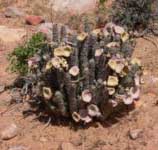Hoodia Gordonii Side Effects

The CSIR (Council of Scientific and Industrial Research) of South Africa patented a native plant, growing wild in the Kalahari Desert, as an aid to weight loss programs. Hoodia Gordonii, as the plant is called, suppresses hunger. The San tribe, who live on the fringes of the Kalahari Desert, used it for thousands of years for that purpose. CSIR isolated a molecule, named P 57, as the active agent that created the feeling of fullness.
P 57 initiates glucose and induces the nerve cells in the hypothalamus, the midbrain, to fire signals that give a feeling of fullness. P 57 is about 10,000 times as effective as glucose. CSIR struck an agreement with the British company Phytopharm to test, develop and market the product. Phytopharm did the only serious clinical study and published its results. In a double blind study, P 57 reduced the intake of calories by 1,000.
P 57 is not a chemical stimulant like Ephedra or Phenfen, but a natural food. During clinical studies, there were no side effects reported. The fact that Hoodia Gordonii products are classified as a food and not a drug is indicative of the safety of the product. Supermarkets are selling it as a food supplement.
Any harmful effect from Hoodia products is caused by misuse. People with eating disorders force themselves to eat because of the hunger. But now they can pop a pill and go about without discomfort. That would prove to be very dangerous to their health. Another safety hazard is the adulteration of Hoodia. As the plant is in short supply, adulteration by the suppliers is rampant. Some manufacturers, knowing this, attempt to make their product effective by adding stimulants like ephedrine and caffeine. This may create unspecified side effects.
The only clinical study done by Phytopharm was not a long-term one, so the long-term side effects are still an unknown factor.
| ALSO ON THIS WEBSITE:
Hoodia Cactus: Effective for Weight Loss
Perhaps you've already heard of hoodia, the unsightly and unpleasant tasting cactus-like plant which grows in the Kalahari Desert. In recent months, hoodia has received an overwhelming amount of attention from the media for it's ability to suppress hunger with no discernable negative side effects. But how exactly does this plant fool our brains into thinking we are full? Read more…
|
|
